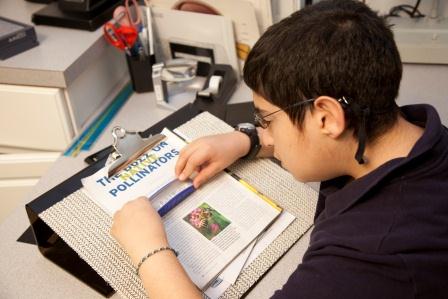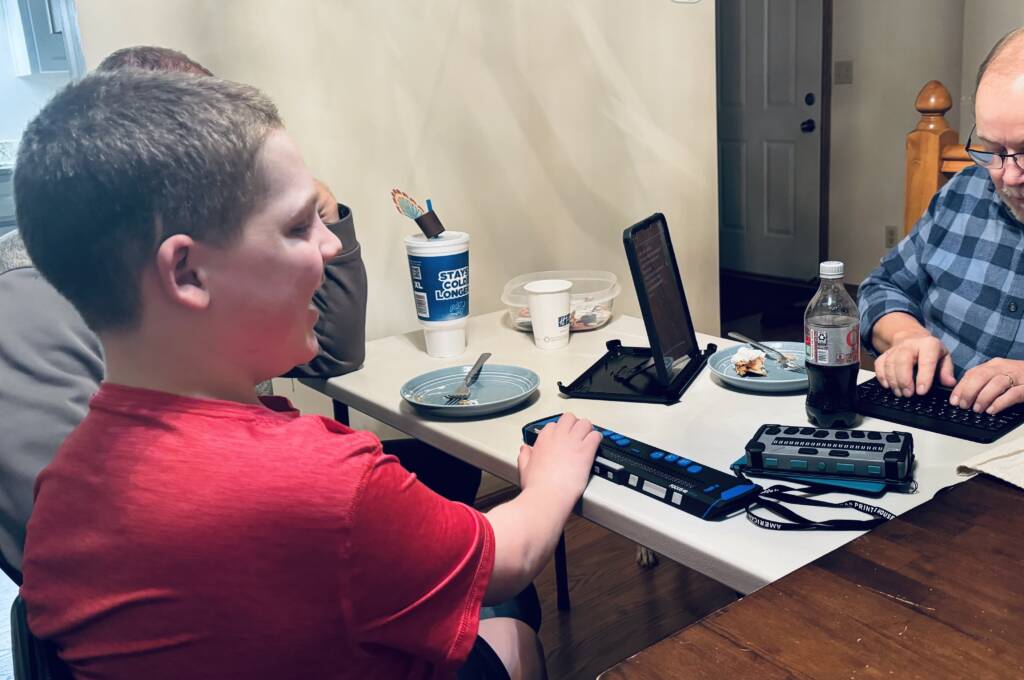Being adept at using technology is essential—in fact critical—for visually impaired students. First, in order to access the environment around them, learn about the world, and function in their daily lives, these students need to learn to use devices that help them gain that access. (Presley and D’Andrea, 2009, p. 4)
What Is Assistive Technology?
 Assistive Technology (AT) can mean a continuum of low to high technology learning equipment or products that will help student’s access or maximize their access to their educational program. Assistive technology is formally defined by IDEA’97 (2000) as, “…any item, piece of equipment, or product system, whether acquired commercially off the shelf, modified, or customized, that is used to increase, maintain, or improve functional capabilities of a child with a disability,” (20 U.S.C. 140(1)). Day and Huefner (2003) offer a comprehensive list taken from the Adaptive Technology Resource Center (2001) list, including items such as: positioning systems, daily living aids, visual aids, auditory materials, motor aids, computer software, switches, refreshable braille, accessibility aids/technology, and the etc.
Assistive Technology (AT) can mean a continuum of low to high technology learning equipment or products that will help student’s access or maximize their access to their educational program. Assistive technology is formally defined by IDEA’97 (2000) as, “…any item, piece of equipment, or product system, whether acquired commercially off the shelf, modified, or customized, that is used to increase, maintain, or improve functional capabilities of a child with a disability,” (20 U.S.C. 140(1)). Day and Huefner (2003) offer a comprehensive list taken from the Adaptive Technology Resource Center (2001) list, including items such as: positioning systems, daily living aids, visual aids, auditory materials, motor aids, computer software, switches, refreshable braille, accessibility aids/technology, and the etc.
AT has improved the lives of students and adults living with visual impairments by providing access, connectedness, and engagement. The use of AT can facilitate a learning environment where students are able to better access their educational program through low or high technology accommodations. The Expanded Core Curriculum (ECC) is the framework for the instruction of students with visual impairments (Hatlen & Sapp, 2010) and can be applied to meet students specific learning needs as well as help plan assistive technology comprehensively.
IDEA extends its definition of AT to include the services associated with the recommended comprehensive scope of devices, equipment, or any product that will help meet the needs of a students individualized learning program. Within IDEA, (34 CFR 300.346(a)(2)(v)), “IEP team also shall…consider whether a child requires assistive technology and services.” And further, recognizes that if the team decides that a student requires assistive technology in order to receive a Free and Appropriate Public Education (FAPE) then it the child is entitled to have assistive technology and technology back and forth from school to home (34 CFR 300.308). In IDEA, a summary of other services related to assistive technology is:
(1) Evaluation regarding AT
(2) Purchasing, leasing, and the like, AT for a student
(3) Selection, design, fitting, customizing, etc. AT for a student
(4) Coordinating and using other therapies and services for a students’ AT implementation
(5) Training and technical assistance regarding AT for student, staff, and family (6) Training for professionals working with student and their AT
But I am a TVI, not an Assistive Technology Teacher…
Kapperman and Sticken (2000) created a comprehensive list of suggestions related to TVIs and AT. As associated with each student’s AT needs, a TVI will:
-
Guide and advocate for AT devices on the educational team

- Conduct appropriate VI-related as well as AT evaluations to determine what device(s) to train students to use
- Advise school district officials on the acquisition of AT devices that will meet each caseload of students’ learning needs
- Guide the individualized education program (IEP) team in creating goals and benchmarks with regard to AT
- Design and provide all the direct instruction to the student regarding how to use appropriate AT device(s)
- Provide ongoing assessment and evaluation of the use of the AT device with the educational team and student
What are the assistive technology needs for students with visual impairments?
The AT needs for students with visual impairments may fall into a couple categories. Students may need AT in order to complete a task, e.g. a student who is blind needs a talking calculator for math computations. A student may also need AT to help enhance and broaden their learning, e.g. after becoming a more proficient writer using a keyboard and a computer the student was able to write a comprehensive essay for her honors ELA class. Yet another category may be a student who needs to become more proficient using high technology, e.g. computers and screen readers, so he or she can feel comfortable in the testing environment completing a computerized assessment.
In order to help in your planning for AT needs for each caseload student, possible AT uses are to:
- Enhance and broaden a student’s ability to engage in the general curriculum.
- Be implemented as an “access skill” in order for students to exhibit the “target skills”.
- Input or output of assignments or in testing environments.



